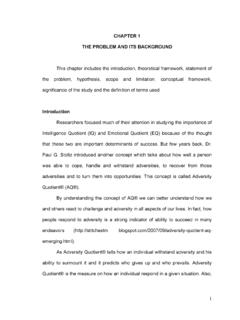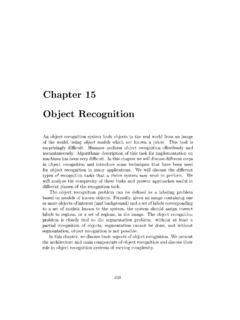Transcription of CHAPTER 1 Violence --- a global public health problem
1 CHAPTER 1 Violence --- a global publichealth problemBackgroundViolence has probably always been part of thehuman experience. Its impact can be seen, invarious forms, in all parts of the world. Each year,more than a million people lose their lives, andmany more suffer non-fatal injuries, as a result ofself-inflicted, interpersonal or collective , Violence is among the leading causes ofdeath worldwide for people aged 15 44 precise estimates are difficult toobtain, the cost of Violence translates into billionsof US dollars in annual health care expendituresworldwide, and billions more for national econo-miesintermsofdayslostfromwork,lawe nforcement and lost visible and the invisibleThe human cost in grief and pain, of course,cannot be calculated.
2 In fact, much of it is almostinvisible. While satellite technology has madecertain types of Violence terrorism, wars, riotsand civil unrest visible to television audiences ona daily basis, much more Violence occurs out ofsight in homes, workplaces and even in themedical and social institutions set up to care forpeople. Many of the victims are too young, weak orill to protect themselves. Others are forced by socialconventions or pressures to keep silent about with its impacts, some causes of Violence areeasy to see. Others are deeply rooted in the social,cultural and economic fabric of human life. Recentresearch suggests that while biological and otherindividual factors explain some of the predisposi-tion to aggression, more often these factors interactwith family, community, cultural and otherexternal factors to create a situation where violenceis likely to preventable problemDespite the fact that Violence has always beenpresent, the world does not have to accept it as aninevitable part of the human condition.
3 As long asthere has been Violence , there have also beensystems religious, philosophical, legal andcommunal which have grown up to prevent orlimit it. None has been completely successful, butall have made their contribution to this definingmark of the early 1980s, the field of public healthhas been a growing asset in this response. A widerange of public health practitioners, researchers andsystems have set themselves the tasks of under-standing the roots of Violence and preventing can be prevented and its impactreduced, in the same way that public health effortshave prevented and reduced pregnancy-relatedcomplications, workplace injuries, infectious dis-eases, and illness resulting from contaminated foodand water in many parts of the world.
4 The factorsthat contribute to violent responses whether theyare factors of attitude and behaviour or related tolarger social, economic, political and culturalconditions can be can be prevented. This is not an articleof faith, but a statement based on of success can be found around theworld, from small-scale individual and communityefforts to national policy and legislative can a public health approachcontribute?By definition, public health is not about individualpatients. Its focus is on dealing with diseases andwith conditions and problems affecting health , andit aims to provide the maximum benefit for thelargest number of people. This does not mean thatpublic health ignores the care of , the concern is to prevent health problemsand to extend better care and safety to public health approach to any problem isinterdisciplinary and science-based (1).
5 It drawsupon knowledge from many disciplines, includingmedicine, epidemiology, sociology, psychology,criminology, education and economics. This hasallowed the field of public health to be innovativeand responsive to a wide range of diseases, illnessesand injuries around the public health approach also emphasizescollective action. It has proved time and again thatCHAPTER 1. Violence --- A global public health efforts from such diverse sectors ashealth, education, social services, justice and policyare necessary to solve what are usually assumed tobe purely medical problems. Each sector has animportant role to play in addressing the problem ofviolence and, collectively, the approaches taken byeach have the potential to produce importantreductions in Violence (see Box ).
6 The public health approach to Violence is basedon the rigorous requirements of the scientificmethod. In moving from problem to solution, ithas four key steps (1):.Uncovering as much basic knowledge aspossible about all the aspects of Violence through systematically collecting data on themagnitude, scope, characteristics and conse-quences of Violence at local, national andinternational why Violence occurs that is,conducting research to determine: the causes and correlates of Violence ; the factors that increase or decrease the riskfor Violence ; the factors that might be modifiablethrough ways to prevent Violence , using theinformation from the above, by designing,implementing, monitoring and , in a range of settings, inter-ventions that appear promising, widely dis-seminating information and determining thecost-effectiveness of health is above all characterized by itsemphasis on prevention.
7 Rather than simplyaccepting or reacting to Violence , its starting pointBOX public health approach in action: DESEPAZ in ColombiaIn 1992, the mayor of Cali, Colombia --- himself a public health specialist --- helped the city set up acomprehensive programme aimed at reducing the high levels of crime there. Rates of homicide inCali, a city of some 2 million inhabitants, had risen from 23 per 100000 population in 1983 to 85 per100000 in 1991. The programme that ensued was called DESEPAZ, an acronym forDesarrollo,Seguridad, Paz(development, security, peace).In the initial stages of the city s programme, epidemiological studies were conducted so as toidentify the principal risk factors for Violence and shape the priorities for action.
8 Special budgetswere approved to strengthen the police, the judicial system and the local human rights undertook education on civil rights matters for both the police and the public atlarge, including television advertising at peak viewing times highlighting the importance oftolerance for others and self-control. A range of cultural and educational projects were organizedfor schools and families in collaboration with local nongovernmental organizations, to promotediscussions on Violence and help resolve interpersonal conflicts. There were restrictions on the saleof alcohol, and the carrying of handguns was banned on weekends and special the course of the programme, special projects were set up to provide economic opportunitiesand safe recreational facilities for young people.
9 The mayor and his administrative team discussedtheir proposals to tackle crime with local people, and the city administration ensured thecontinuing participation and commitment of the the programme in operation, the homicide rate in Cali declined from an all-time high of124 per 100 000 to 86 per 100000 between 1994 and 1997, a reduction of 30%. In absolutenumbers, there were approximately 600 fewer homicides between 1994 and 1997 compared withthe previous 3-year period, which allowed the law enforcement authorities to devote scarceresources to combating more organized forms of crime. Furthermore, public opinion in Calishifted strongly from a passive attitude towards dealing with Violence to a vociferous demand formore prevention REPORT ON Violence AND HEALTHis the strong conviction that violent behaviour andits consequences can be violenceAny comprehensive analysis of Violence shouldbegin by defining the various forms of Violence insuch a way as to facilitate their scientific measure-ment.
10 There are many possible ways to defineviolence. The World health Organization definesviolence (2) as:The intentional use of physical force or power,threatened or actual, against oneself, anotherperson, or against a group or community, thateither results in or has a high likelihood ofresulting in injury, death, psychological harm,maldevelopment or definition used by the World health Organi-zation associates intentionality with the committingof the act itself, irrespective of the outcome itproduces. Excluded from the definition are uninten-tional incidents such as most road traffic injuriesand inclusion of the word power , in additionto the phrase use of physical force , broadens thenature of a violent act and expands the conventionalunderstanding of Violence to include those acts thatresult from a power relationship, including threatsand intimidation.

















